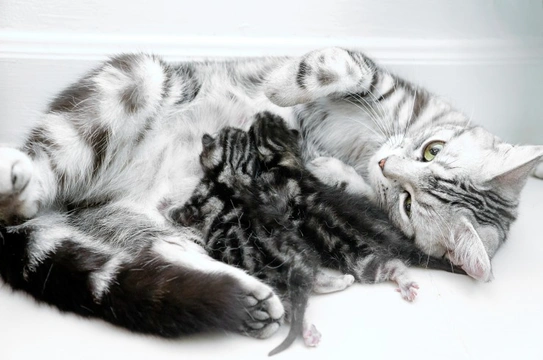
Agalactia (reduced milk production) in Cats
Agalactia is a condition that affects a female cat's milk production and it is one of around five health issues they can develop once they have given birth to a litter of kittens. Unfortunately, the problem can develop without prior warning and is one of the disorders that affects thousands of female cats every year in the UK with certain breeds being more susceptible to developing agalactia than others.
Agalactia Explained
The condition typically develops once a female cat has given birth to a litter of kittens which can put her offspring at risk more especially as kittens often can't get their first important drink of milk which contains valuable colostrum. Although the condition does not harm the mother cat in any way, kittens quickly become dehydrated which can prove fatal. When a mother cat cannot produce enough milk to feed her offspring, it's important to step in and start bottle feeding her kittens which can in itself prove quite challenging.
Just why some female cats develop the condition remains a bit of a mystery, but research suggests that it is a rare disorder that should not affect a healthy pregnant female cat more especially if they have been correctly fed throughout her pregnancy. Another reason why a cat might not be able to produce enough milk to feed her kittens could be due to an underlying infection she has developed. As such, once a cat has given birth to her offspring, it's important for owners to keep a close eye on her kittens and to make sure they are drinking and that the mother cat is producing milk. A nursing kitten will typically have a little milk on their muzzles once they have suckled and a mother's teats should be full of milk in between the times she is feeding the kittens.
Infections a Nursing Mother May Develop
As previously mentioned, a cat can develop an infection which could mean she cannot produce enough milk to feed her kittens. Some of the conditions that could lead to a serious infection if left untreated include the following:
Metritis
One of the infections a female cat can develop after she has given birth is known as metritis"". The infection takes hold in a cat's uterus and it typically flares up because some placental tissue gets left behind after she has given birth to her kittens. As the placental tissue starts to decompose, it can lead to a very serious infection taking hold in a cat's uterus. The signs to watch out for that there could be something wrong include the following:
- An elevated temperature/fever
- A nasty discharge from a cat's uterus that's quite smelly
- Lethargy
Should a cat develop metritis after she has given birth, she would need to undergo a hysterectomy to save her life.
Pyometra
Another cause of an infection is known as pyometra which is a condition that only unspayed females develop. It is a bacterial infection that takes hold in a cat's uterus and if left untreated, pus builds up which can lead to all sorts of complications. This includes internal bleeding. Should this happen, it often proves fatal. Any female cat suspected of having developed any sort of infection in their uterus should be taken to the vet as soon as possible so a correct diagnosis can be made and the condition treated. Should the vet discover a cat is suffering from pyometra, they would recommend carrying out a full hysterectomy which would save the cat's life.
Mastitis
Another reason why a female cat might not be able to feed her kittens is because she has developed a condition known as mastitis. This is an infection that flares up in a cat's milk ducts which become blocked. Providing the condition is caught early enough, mastitis is easily treatable by gently pressing on a cat's teat to clear the blockage. If the condition is left untreated, it can lead to a cat's teats becoming extremely sore and swollen. In a worst-case scenario, pus can build up inside a teat which then becomes distended, turning a nasty purple colour. A cat would need to be examined by a vet who would typically prescribe a course of antibiotics to clear up the infection. Should any kittens swallow any of the bacteria, it could prove fatal which is why a nursing cat suspected of having developed mastitis should be taken to the vet as a matter of urgency.
Cancer
Unfortunately, when a female cat remains unspayed she is more at risk of developing mammary cancer and the breed most at risk is the Siamese. The signs to watch out for when the tumours start to develop could include the following:
- Hard lumps just under the skin
- Fever
- Infection
- Pain
- Swelling
Managing a Cat's Condition
Providing the problem is caught early, kittens can be hand fed to ensure they do not dehydrate or become malnourished. The mother should be examined by a vet who would be able to diagnose the problem and set up a treatment plan sooner rather than later not only to save the kittens lives, but their mother's too.
""



